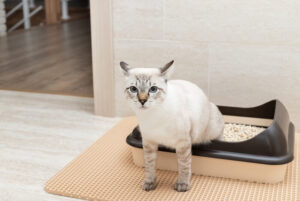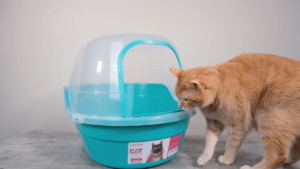Even if a cat has unrestricted access to the outdoors, it’s best to keep litter boxes indoors in case your cat doesn’t feel safe toileting outside or struggles to make it to the backyard fast enough due to old age or mobility problems.
You can never have enough litter boxes if you’re a cat, so let’s examine the proper number of litter trays per household, including the ins and outs of litter boxes.

How Many Litter Boxes Do Cats Need?
In multi-cat households, there’s always a need to provide sufficient resources like feeding stations, cat trees, and beds to avoid conflict and reduce competition, and the identical advice applies to litter trays.
The consensus of feline behaviorists is you should have one litter box per cat, plus one more box. Litter boxes should be placed in multiple locations around your home.
Cats who toilet outdoors, generally prefer to urinate and defecate in separate locations. To imitate the ideal litter facilities indoors, you can provide two trays per cat.
Determining How Many Litter Boxes You Need
To determine the number of litter boxes you need, count the number of cats in the household, then add one more. For example, if you have two cats, the minimum number of trays is three. If you have three cats, then the minimum number is four. It never hurts to keep more litter boxes, so don’t hesitate to keep two boxes per cat if you have the space.
If you reside in a small dwelling with several cats, the compromise is to identify the number of social groups of cats and how well they get along. If you have cohesive groups, you can try one litter box per social group plus one extra.
Tips for Litter Box Success

Regardless of the large variety of litter box products on the market, from a cat’s point of view, the litter box just needs to feel safe, be clean, and be filled with two to three inches of a sand-like substrate to bury and conceal their physical waste.
In order to find out which litter substrate your cat likes, conduct a litter preference test by providing a set of trays containing diverse litter material. If you have a new cat, keep using the same litter they used before (if you know what it was).
Litter box size is very important. The rule of thumb is the box should be at least 1.5 times the length of the cat from the nose to end of the tail. The box should be sturdy and wide enough for your cat to turn around fully, dig, and cover their waste without any constraint. Kittens can start with a small tray, however as they grow up, upgrade their litter box to a bigger size.
Scoop the litter boxes multiple times a day, and completely clean them at least once a week. Cats are more likely to consistently use the boxes when they are kept clean.
Lastly, if your cat is elderly or struggles to climb in or out of the litter box, then supply a large tray with a shallow rim to minimize discomfort.
Where To Place Litter Boxes
Place litter boxes in secluded areas or quiet corners away from heavy foot traffic, and ensure cats have visibility of their surroundings with the safety of a wall or sturdy object behind.
If the cat lives in a multi-story home, place a litter box on each floor preferably, especially if you have a kitten or an elderly cat, to minimize house-soiling accidents. If your cat lives with a dog that tends to invade the litter tray, place the litter boxes in a room protected by a baby gate or install a microchip cat flap within the door.
Do not place litter boxes close to busy thoroughfares, cat flaps that lead outdoors, glass windows, or home entry and exit points so the cat doesn’t get disturbed or feel vulnerable while toileting. Equally, keep litter trays far from food plus water stations and away from any loud noises or vibrations produced by washing machines, dryers, and dishwashers.
Can You Put Litter Boxes Side by Side?
Do not place litter boxes side by side, particularly in multi-cat households. Ideally, place trays in various parts of the house to minimize felines being cornered, blocked off, or guarded by assertive cats.
What To Do if Your Cats Aren’t Using the Litter Box

If your cats aren’t using the litter box, try putting out extra litter boxes in new places and consider upgrading to larger boxes. You can also conduct litter preference tests, temporarily restricting access to certain parts of the home during the test.
Experiment with different type litter, try covered or open trays, adjust the depth of the litter, and scoop the waste multiple time per day to see if it makes any difference. Record daily elimination habits in a diary to determine your cat’s preference.
If your cat still refuses to use the litter box, or if the cat begins soiling outside the box, take your cat to the veterinarian for a medical checkup. Mention any behavioral changes to your vet, regardless of how subtle they are.
Conclusion
It’s vital to provide enough litter boxes to ensure cats feel comfortable toileting. Creating the idea litter box setup in your home can decrease or completely eliminate accidents outside the box.

